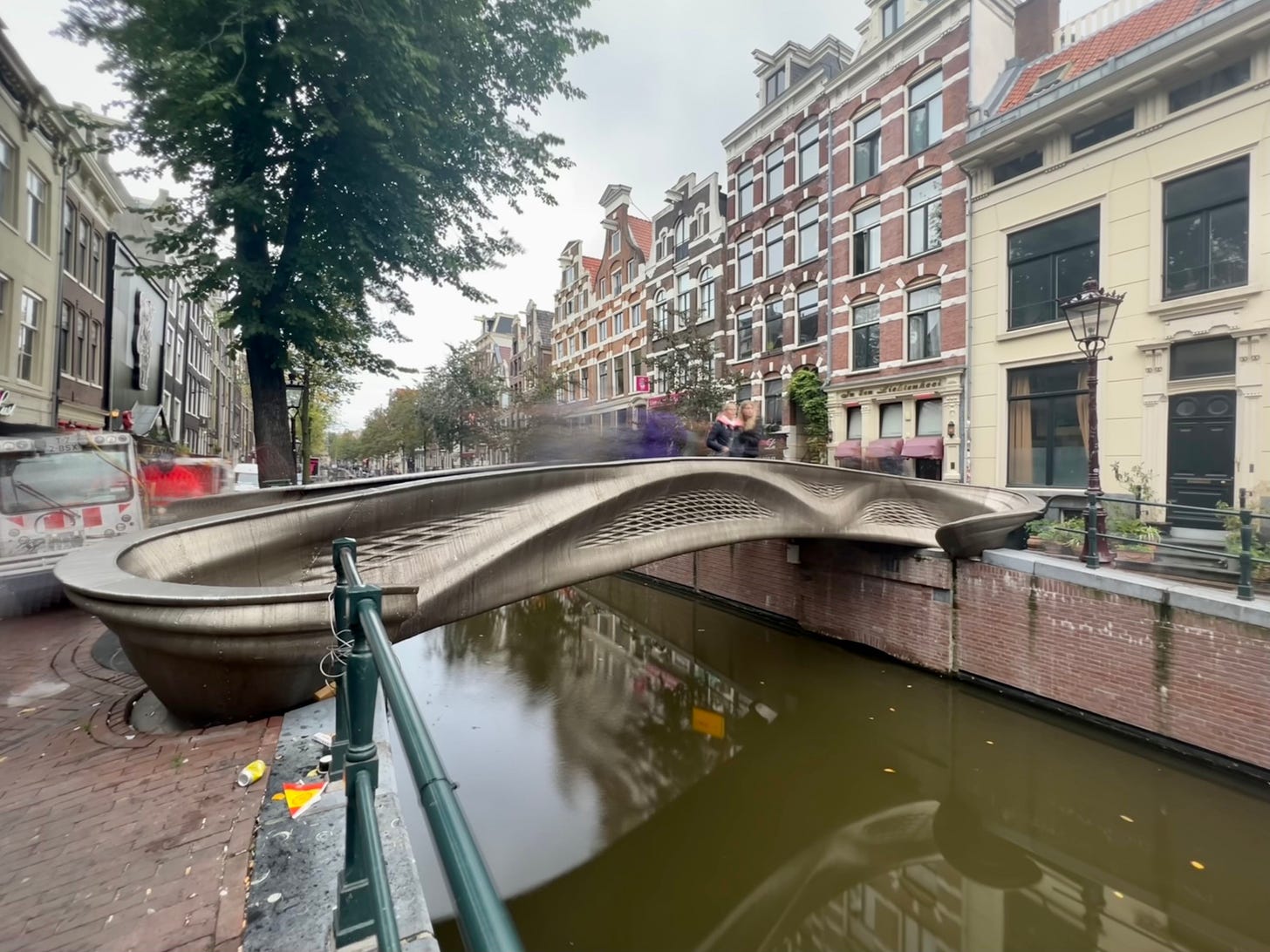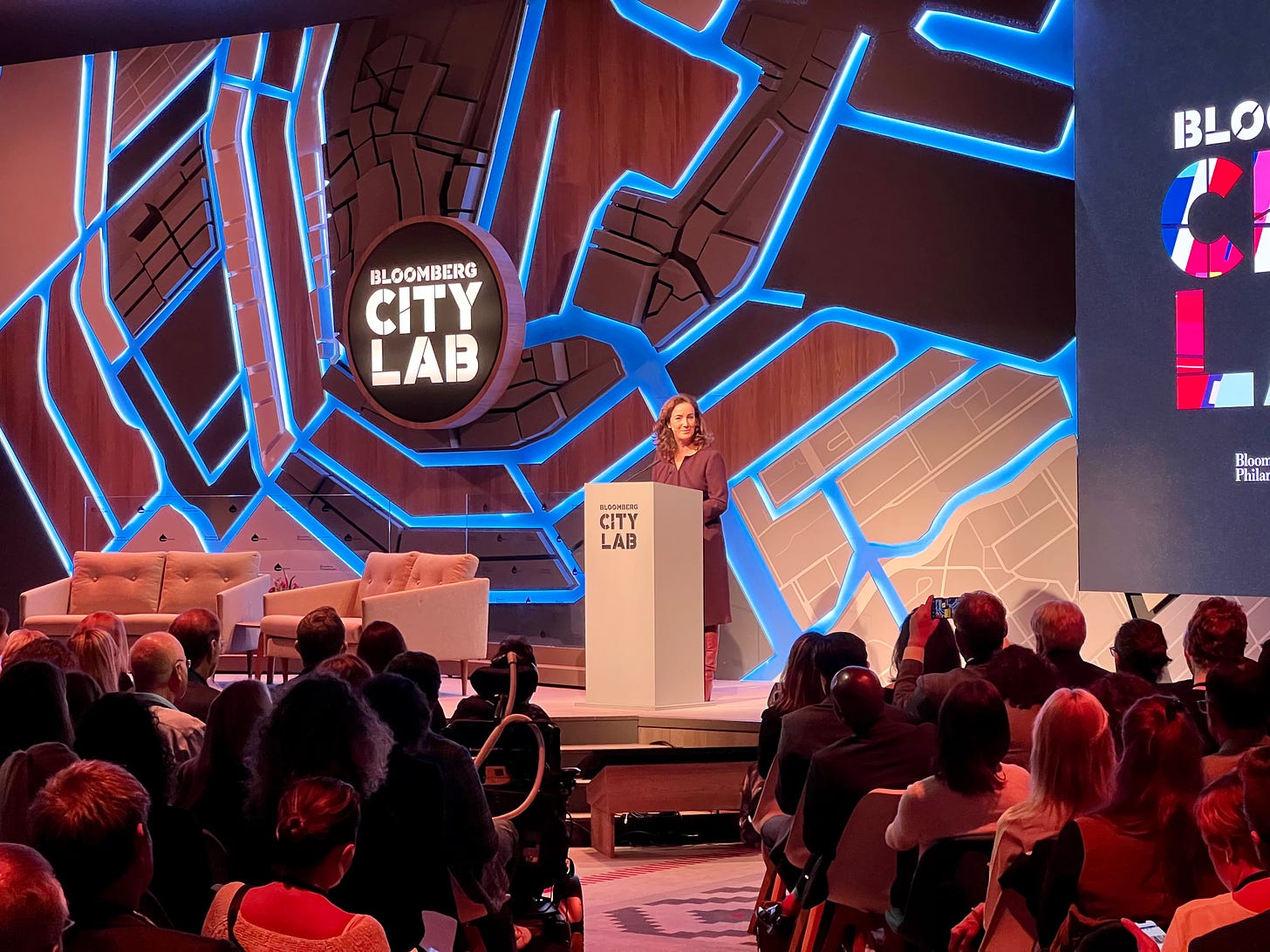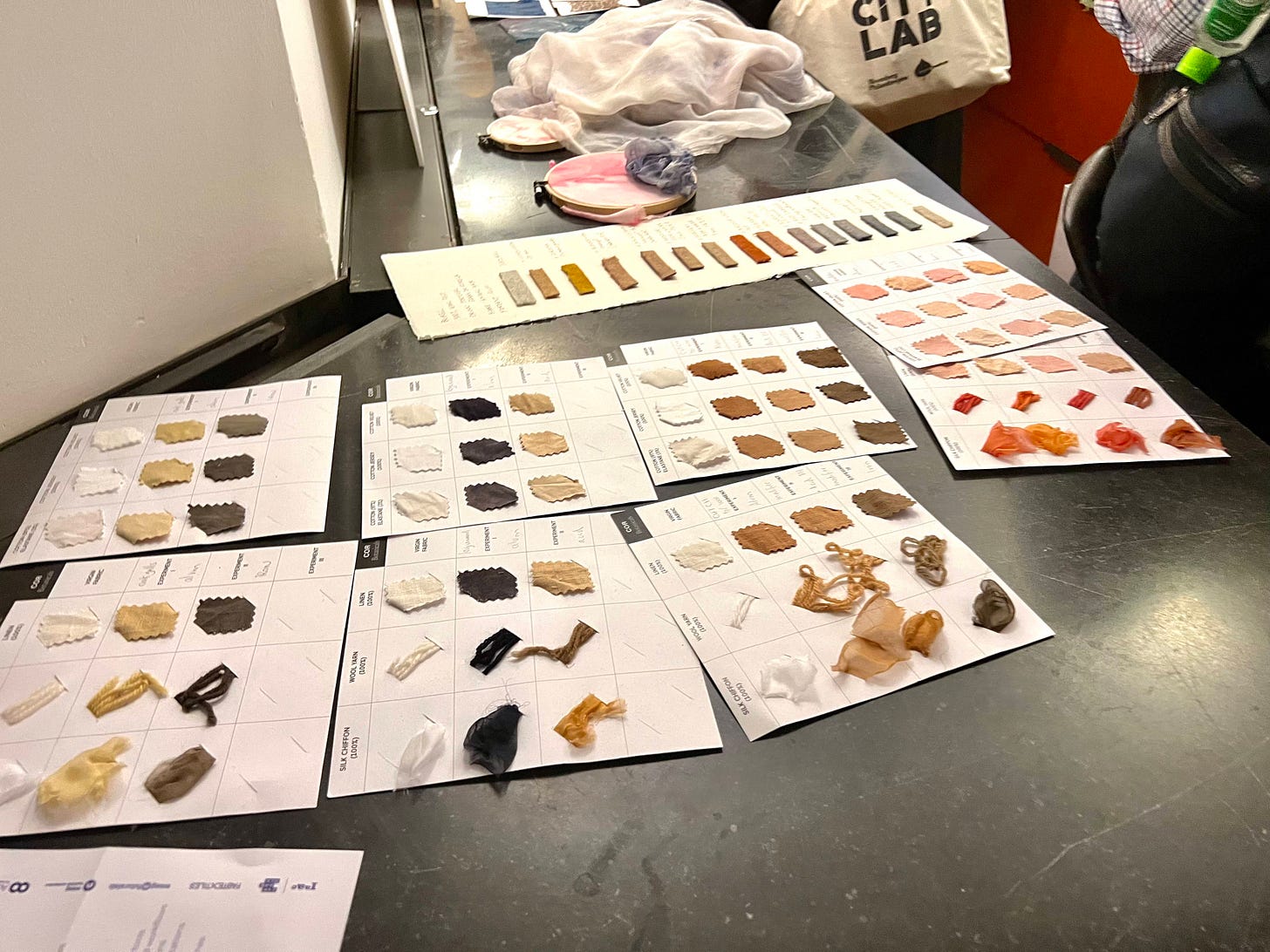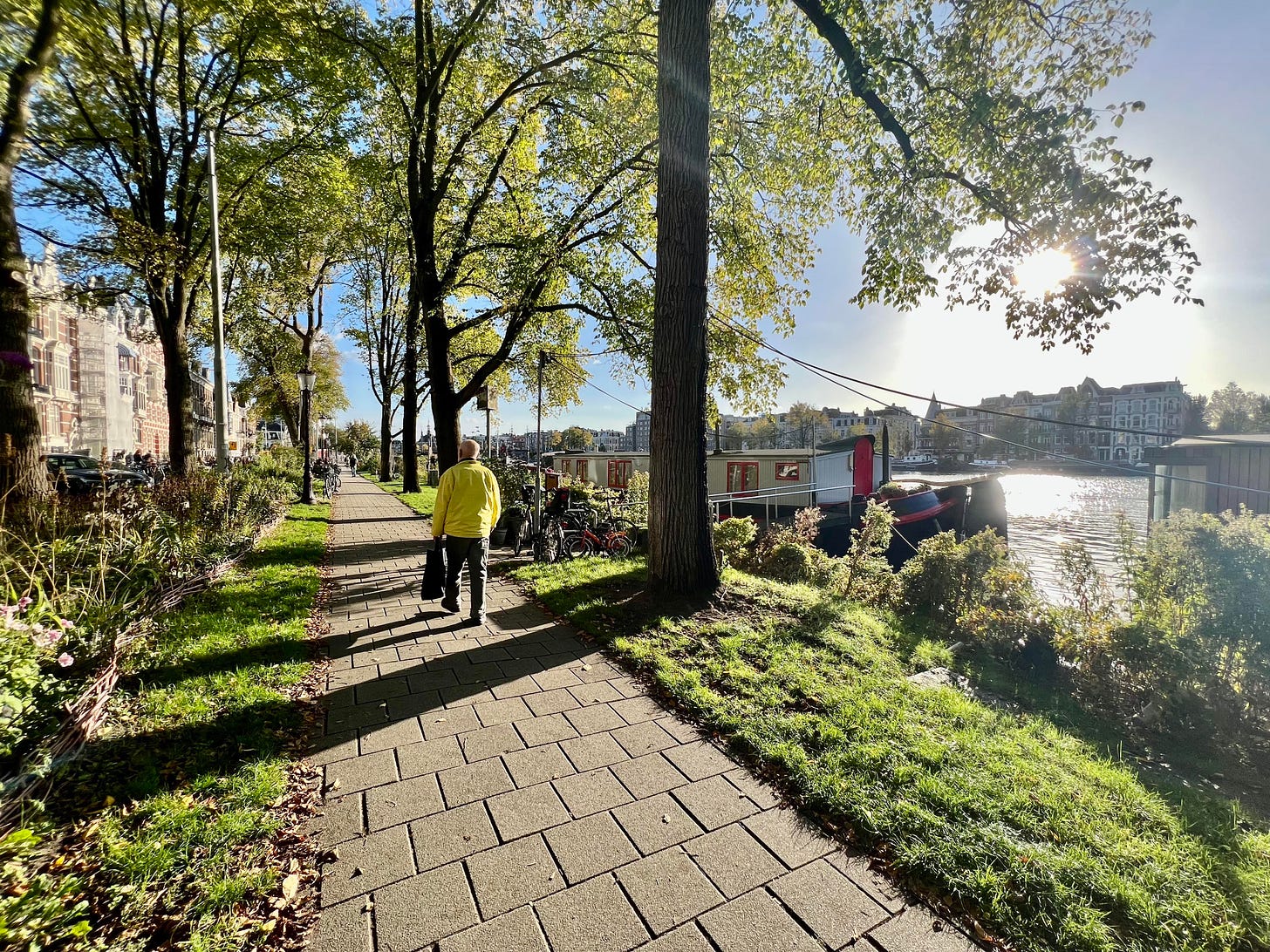Urban Technology at University of Michigan week 116
Tour of Amsterdam’s latest urban technologies
Few places in the world afford the opportunity to visit a maker space in a castle-like building from the 15th century, or a bridge 3D printed in stainless steel. It’s rare to have the chance to meet an autonomous boat. Two days in Amsterdam produced all of this and more. In this issue we’re bringing you a whirlwind tour of Old Amsterdam’s newest ideas and experiments.
I expected the 3D printed wizardry and the photogenic maker spaces and I had already read about the ROBOAT many times, but learning about these things and the milieu in which they have been and are being developed put these examples of urban technology into a new and more meaningful light.
If you zoom out from the tech itself, what Amsterdam as a collective of people, companies, and institutions is doing is to prototype a new form of self reliance that is native to the 21st century where technology is sovereign, circular, and authentic. After three days in Amsterdam with the generous folks at Bloomberg CityLab, Waag FutureLab, AMS Institute, and Tellart I’m a believer.
💬 Hello! This is the newsletter of the Urban Technology program at University of Michigan, in which we explore the ways that technology can be harnessed to nurture and improve urban life. If you’re new here, try this short video of current students describing urban technology in their own words.
👑 Sovereign Digital Platforms
Bloomberg hosts a splashy event for urban leaders called CityLab every couple years that brings together mayors, public servants, and others working on public challenges and urban innovation writ large. This year with the event hosted in Amsterdam, Mayor Femke Halsema gave opening remarks that situated her city’s efforts to deliver a uniquely Dutch approach to governance.
In the Mayor’s telling, her aspirations stand in contrast to the digital life that most people live today where, “the citizens in almost all of our cities rely on digital platforms owned by large tech companies” to do just about everything, while being subject to “algorithms [that harbor] a toxic mix of commercial and political influences.” So, the answer?
In a truly public digital city, Mayor Halsema argued, citizens are owners of their data, have a democratic influence over what is built, and share in any value created by digital platforms that are publicly owned. Building this will not be simple, and the mayor acknowledged that by invoking the need to adopt an ambitious “mission-based” approach as advocated for by Mariana Mazzucato: “Without undue surveillance… the digital republic can be a moonshot” of the 21st century, as the Apollo program was for America in the 20th century. In blunter terms: the Mayor wants to make the means of digital production local so that Amsterdam (and others in the Netherlands) have sovereignty over their digital lives and are less reliant upon the limited range of available options produced by Silicon Valley. This means new tech, new business models, new governance schemes, new APIs, and the list goes on. It is, in short, a ton of work. Moonshot indeed! Though not without precedents, such as the inspiring work of Gov.UK.
Inspiring as this ambition of digital sovereignty might be, is it anything more than a Dutch dream? Indeed, an active coalition of Dutch organizations called PublicSpaces are already working toward a related idea:
PublicSpaces is a coalition of organizations that feel that something has been lost during the development and growth of the internet. The coalition feels that we need to have a real ‘public domain’ back online, where public services can be delivered without any open or hidden agenda driven by commercial or particular political motives. PublicSpaces is open to any party that subscribes to the basic principles and values as set out in our manifesto.
Foundation for Public Code is working on this as well, by offering stewardship of codebases that are created by public organizations and licensed as open source… almost like digital facilities managers, janitors, and strategic advisers all rolled into one. Aside: In the 20th, century janitors’ uniforms had an iconic identity that’s now carried forth by companies like Carhartt. What will the uniform of the digital janitor be?
The theme of sovereignty showed up at different scales. A 20 minute bike ride away from the conference where Mayor Halsema gave the opening remarks, AMS Institute is prototyping a handful of technologies at their HQ on the grounds of a former naval base.
Their Responsible Sensing Lab is an experiment in reducing the amount of data that a digital sensor in public space collects to the minimum needed while also communicating why and how that information is collected. This shares an ethos with Digital Transparency in the Public Realm project we’ve written about previously but goes a little further.
Any single one of these data points—a driven Mayor, a broad coalition, an emerging non-profit consultancy, active experiments in building sovereign technologies—are not enough on their own to signify a tipping point, but together they form a strong constellation of overlapping interests with real muscle behind it. Sovereignty here is something very special. It’s networked, interdependent, and driven by values.
♻️ Circular Economies Online and Off
Built in 1488 (or maybe 1423 depending on who you ask), Amsterdam’s Weighing House is the second oldest building in town, and was built to weigh commodities and decide their economic value. Five hundred years later (!!!) it’s home to the Waag Futurelab, which is a collection of labs exploring questions of makership from the starting belief that technology is anything but neutral. If that’s the case, what you build is shaped by who is involved in its construction, and how exactly the making is conducted.
Whereas many places are still getting up to speed with effective public-private partnerships, the Waag have already added a third circle to the Venn diagram and are articulating a public-private-civic collaboration model. Though interesting in its own right, Bart Tunnissen and his colleague Sander van der Waal welcomed our CityLab tour group while explaining that this model is instrumental to helping the city enact its values: “We need makership in our city if we’re going to become a circular economy.”
Waag’s perspective on the importance of instilling a maker ethos is manifold. Yes, it’s cool to do things like make a cellphone built from fair and recycled materials, but it’s even cooler when the process of inventing such a thing is collaborative and participatory. That means in addition to the product emerging out of the process, there’s also an opportunity for public education experiences along the way. Making something together is not about sharing the burden, but about ripening the results by making room for more perspectives and a richer articulation of the principles that drive this collective effort.
With seemingly every project they take on, Waag Futurelab deconstructs the subject matter to its core components to better reimagine their use, and eventually build something anew. Questions of sovereignty are alive here too, such as with their Public Stack for Charging Electric Vehicles project (mostly in Dutch but here’s a more generalized exploration of the public stack). Or their TextileLab’s efforts to develop circular textile dyes entirely sourced from organic ingredients found within Amsterdam’s city limits.
Not sure if local dye is the Most Pressing Challenge Faced by Humankind or The City of Amsterdam but that’s the point of a lab, isn’t it? Making real experiments and being open to what comes next. In the case of the Waag’s work, their multifaceted, multi-decade effort to establish a maker society is now coming to fruition in both digital and physical realms at the same time. What comes next is a circular economy in Amsterdam where you order your food using a locally built app, pay with a locally built digital payment platform, eat produce grown within city limits, and discard (if anything) materials that fuel the production line of the souvenir scarf you take home the next day.
🛳 Authentic Robots
After passing AMS Institute’s Responsible Sensing Lab installation and shuffling up a couple flights of stairs, one arrives to a compact hive of urban technology researchers and students. For an American, even one who lived and worked in Europe for a good chunk of time, AMS Institute feels like a dream. After getting past the different funding structures of European and American universities, what I realized about the slightly stunned feeling I had while visiting AMS Institute is not that it’s some utopian concoction of expertise, funding, and possibility, but that they’ve managed to bring a hyper local focus to urban technology like few have been able to accomplish.
I never heard my gracious host Stephan van Dijk say this, but it’s almost as if the mission of AMS Institute is to build the most specific versions of technology possible while trusting that if you do so, broader future opportunities will emerge. This notion is in great contrast to a more typical approach to tech that seeks to identify the broadest possible needs and build widely-applicable solutions. But then again, if you’re building for the top of the bellcurve you never assemble a ROBOAT as your first autonomous device.
ROBOAT is an autonomous skiff that shuttles supplies and waste through the city. It’s the same idea that many a lab has built for land, except this one cruises through the water and gets a cheekier name. If we looked at this from an investment lens, it would perhaps not seem like the first place to invest time and effort if you’re trying to make a product that will be financially successful. However, consider this: lots of cities have waterways (did you know Detroit has a canal district?) and traveling by water can be very carbon efficient. Up through most of the 20th century urban shorelines were primarily a place of dirty and dangerous work. Now in the 21st century they’re mostly becoming places of tourism and leisure. But as the technology of waterborne navigation changes and the vehicles become electric, maybe the uses of logistics and leisure do not have to be mutually exclusive. Or maybe building an autonomous system for canals is a precursor to doing something similar for the seas?
Starting with an authentic local need (waterborne navigation of stuff) produced a novel solution (ROBOAT) that solves local needs while also addressing local culture (among ROBOAT’s many jobs as a prototype was to make hyperlocal deliveries for a brewery that sits opposite AMS Institute’s HQ) and results in the development of core technologies (nav algorithms, propulsion systems, docking systems, etc.) that have use beyond the original context and application.
This approach of solving hyperlocal problems that AMS Institute have used with ROBOAT is also being applied to social housing, quay walls, and other challenges around the city. By working on the unique challenges of their own community, AMS have a true need for local talent to help co-create their inventive products and projects, and a genuine source of collaboration with the public sector whose involvement they need to make urban infrastructure a viable subject matter of research and development. This is a circular economy of ideas, both necessary and authentic.
Later that evening I shared reflections with fellow conference-goer Sarah Ichioka, a strategist and curator working on environmental issues around the globe. Struggling to find the right words, I recalled how the streets of Amsterdam are a happy kind of chaos where cyclists and pedestrians navigate around each other and seldom do you see anyone eat bricks. “But it’s not orderly it’s more…” my thoughts trailed off… “Emergent,” Sarah Replied in a way mimicking the effortless unfolding of urban life around us. Would the amount of coordination required to pull of any of AMS institutes’s projects be possible in a place that demands order more than emergence? Is the Dutch comfort with emergence what enables such authentically local work to get off the ground without worrying overly much about the investment case and future growth potential?
💗 Scale
Though buzzwords like smart cities, govtech, civic tech, and perhaps even urban tech are fading in relevance, the work being done by groups like the City of Amsterdam, Waag FutureLab, and AMS Institute is more important than ever precisely because it is now real. Real hard to do. But also real as in results are visible. Canals being shored up and then traversed autonomously thanks to the steady development of urban technologies. Communities manifesting their own idiosyncratic destinies by making the tools they need to live together in ways that are satisfying to them. Products manufactured in a circular economy really on sale.
In the closing session of the conference, Jim Anderson of Bloomberg Philanthropies asked Mexico City Mayor Claudia Sheinbaum to share some of her city’s successes to date and the numbers create their own impressive gravity. After launching the Llave digital identity system (“key” in English), 65% of adults in the city are using it to access government services. After starting with less than a hundred free wifi hotspots in 2019, the Mayor described being on track to have a network of some 33,000 by the end of the year.
Beyond the numbers, it’s also worth noting that the Mayor is directing her team in city government to build the software with internal capacity, augmented, of course, with new coders, designers, and more. Self reliance cannot be built by consultants. Build technologies that are needed as expressed by your people, useful as acknowledged by your people, and created literally by your people—with their local muscle and brain power. And how? Mayor Sheinbaum answers without hesitation: “Believe in your people, always.” Urban Technology is no place for mere “users.”
These weeks: Curriculum tightening, interviewing, hiring, airporting, whiteboarding. 🏃








Haha well I have things to say about natural dyes ☺️ this is where your program and mine collide
Wow - what a wonderful trip. And post. Thank you.